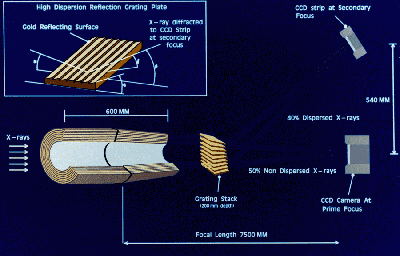

![]() Reflection Grating Spectrometer (RGS)
Reflection Grating Spectrometer (RGS)

Two of XMM's X-ray telescopes will also
incorporate a reflection grating spectrometer for measuring the
wavelengths of incoming X-rays. The Reflection Gratings share the
collected X-rays with the EPIC camera on the same telescope, each
receiving about 50% of the collected radiation. In the grating
spectrometer, the X-ray beam is bent through an angle which is nearly
proportional to its wavelength and then recorded on another MOS CCD
camera. These cameras are elongated so that they can collect light
diffracted over a range of angles corresponding to different X-ray
wavelengths.
When XMM is observing an astronomical source,
the x-rays are often concentrated at particular wave lengths or spectrum lines which correspond to the chemical
elements present in the source. This allows its chemical composition
and temperature to be deduced.
To find out more about the RGS, click here and follow the links to
instrumentation.


